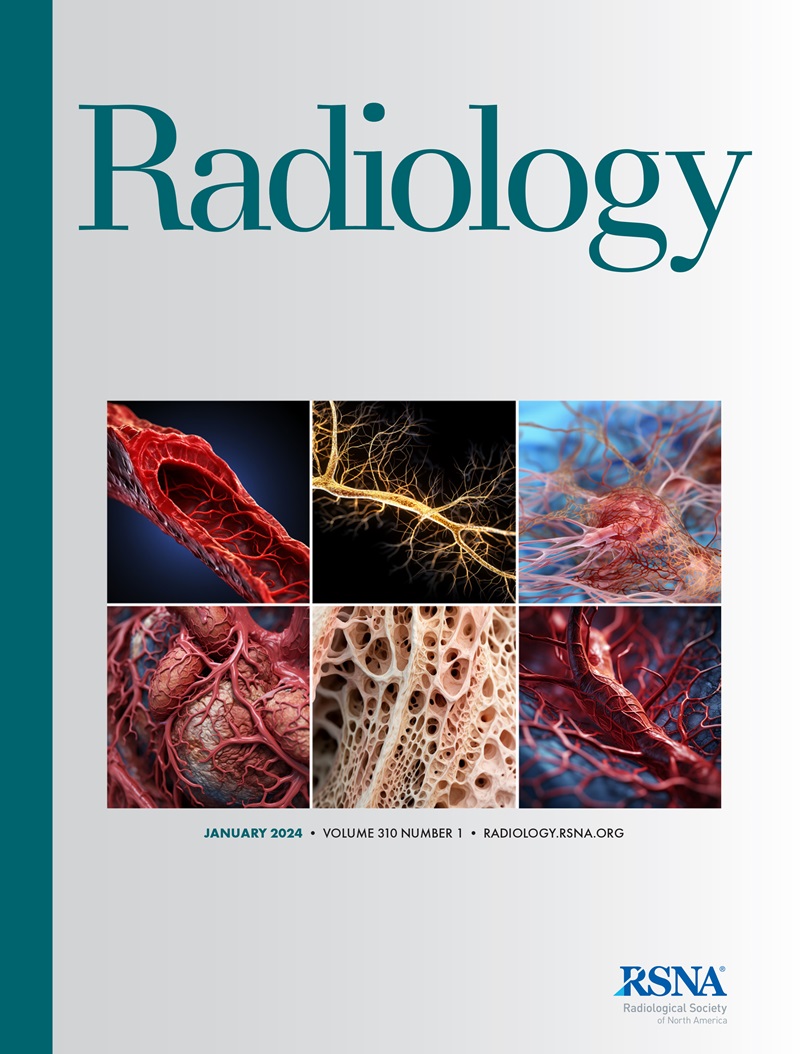Yanning Liu, Henk M De Feyter, Zachary A Corbin, Robert K Fulbright, Scott McIntyre, Terence W Nixon, Robin A de Graaf
求助PDF
{"title":"多层对比MRI和氘代谢成像并行检测用于神经系统疾病的高效表征。","authors":"Yanning Liu, Henk M De Feyter, Zachary A Corbin, Robert K Fulbright, Scott McIntyre, Terence W Nixon, Robin A de Graaf","doi":"10.1148/radiol.241597","DOIUrl":null,"url":null,"abstract":"<p><p>Background Deuterium metabolic imaging (DMI) is a novel, MRI-based method to map metabolism noninvasively in vivo and has potential to augment existing clinical MRI with unique metabolic information. However, adding DMI scans to a standard, clinical MRI protocol is challenging due to the relatively long scan time of DMI that can result in decreased patient compliance and increased scanning costs. Purpose To design and evaluate a parallel acquisition strategy, based on the large frequency difference between hydrogen proton (<sup>1</sup>H) and deuterium (<sup>2</sup>H) MRI signals, to obtain metabolic DMI data during a comprehensive, multicontrast (fluid-attenuated inversion recovery [FLAIR] and T1-, T2-, and susceptibility-weighted) MRI protocol without adding scanning time. Materials and Methods A parallel MRI DMI protocol based on four essential MRI types-FLAIR, and T1-, T2-, and susceptibility-weighted MRI-was interwoven with three-dimensional DMI by executing <sup>2</sup>H acquisition blocks during the contrast-generating delays intrinsic to MRI. Results Phantom and in vivo human brain data show that MRI scan quality, DMI sensitivity, and information content are preserved in the parallel MRI DMI acquisition method. DMI data acquired in parallel with MRI in a patient with an astrocytoma show unique metabolic image contrast that complements the multicontrast MRI examinations. Conclusion Parallel MRI scan acquisition technology was a practical solution to obtain both high-quality anatomic and metabolic scans without prolonging the scanning duration compared with an MRI-only protocol; the method had high flexibility to upgrade traditional MRI protocols with DMI and will be key for many clinical sites to gain access to DMI and drive its further development and validation by use in larger, diverse patient populations. © RSNA, 2025 <i>Supplemental material is available for this article</i>. See also the article by Bøgh et al in this issue. See also the editorial by Port in this issue.</p>","PeriodicalId":20896,"journal":{"name":"Radiology","volume":"315 1","pages":"e241597"},"PeriodicalIF":12.1000,"publicationDate":"2025-04-01","publicationTypes":"Journal Article","fieldsOfStudy":null,"isOpenAccess":false,"openAccessPdf":"","citationCount":"0","resultStr":"{\"title\":\"Parallel Detection of Multicontrast MRI and Deuterium Metabolic Imaging for Time-efficient Characterization of Neurologic Diseases.\",\"authors\":\"Yanning Liu, Henk M De Feyter, Zachary A Corbin, Robert K Fulbright, Scott McIntyre, Terence W Nixon, Robin A de Graaf\",\"doi\":\"10.1148/radiol.241597\",\"DOIUrl\":null,\"url\":null,\"abstract\":\"<p><p>Background Deuterium metabolic imaging (DMI) is a novel, MRI-based method to map metabolism noninvasively in vivo and has potential to augment existing clinical MRI with unique metabolic information. However, adding DMI scans to a standard, clinical MRI protocol is challenging due to the relatively long scan time of DMI that can result in decreased patient compliance and increased scanning costs. Purpose To design and evaluate a parallel acquisition strategy, based on the large frequency difference between hydrogen proton (<sup>1</sup>H) and deuterium (<sup>2</sup>H) MRI signals, to obtain metabolic DMI data during a comprehensive, multicontrast (fluid-attenuated inversion recovery [FLAIR] and T1-, T2-, and susceptibility-weighted) MRI protocol without adding scanning time. Materials and Methods A parallel MRI DMI protocol based on four essential MRI types-FLAIR, and T1-, T2-, and susceptibility-weighted MRI-was interwoven with three-dimensional DMI by executing <sup>2</sup>H acquisition blocks during the contrast-generating delays intrinsic to MRI. Results Phantom and in vivo human brain data show that MRI scan quality, DMI sensitivity, and information content are preserved in the parallel MRI DMI acquisition method. DMI data acquired in parallel with MRI in a patient with an astrocytoma show unique metabolic image contrast that complements the multicontrast MRI examinations. Conclusion Parallel MRI scan acquisition technology was a practical solution to obtain both high-quality anatomic and metabolic scans without prolonging the scanning duration compared with an MRI-only protocol; the method had high flexibility to upgrade traditional MRI protocols with DMI and will be key for many clinical sites to gain access to DMI and drive its further development and validation by use in larger, diverse patient populations. © RSNA, 2025 <i>Supplemental material is available for this article</i>. See also the article by Bøgh et al in this issue. See also the editorial by Port in this issue.</p>\",\"PeriodicalId\":20896,\"journal\":{\"name\":\"Radiology\",\"volume\":\"315 1\",\"pages\":\"e241597\"},\"PeriodicalIF\":12.1000,\"publicationDate\":\"2025-04-01\",\"publicationTypes\":\"Journal Article\",\"fieldsOfStudy\":null,\"isOpenAccess\":false,\"openAccessPdf\":\"\",\"citationCount\":\"0\",\"resultStr\":null,\"platform\":\"Semanticscholar\",\"paperid\":null,\"PeriodicalName\":\"Radiology\",\"FirstCategoryId\":\"3\",\"ListUrlMain\":\"https://doi.org/10.1148/radiol.241597\",\"RegionNum\":1,\"RegionCategory\":\"医学\",\"ArticlePicture\":[],\"TitleCN\":null,\"AbstractTextCN\":null,\"PMCID\":null,\"EPubDate\":\"\",\"PubModel\":\"\",\"JCR\":\"Q1\",\"JCRName\":\"RADIOLOGY, NUCLEAR MEDICINE & MEDICAL IMAGING\",\"Score\":null,\"Total\":0}","platform":"Semanticscholar","paperid":null,"PeriodicalName":"Radiology","FirstCategoryId":"3","ListUrlMain":"https://doi.org/10.1148/radiol.241597","RegionNum":1,"RegionCategory":"医学","ArticlePicture":[],"TitleCN":null,"AbstractTextCN":null,"PMCID":null,"EPubDate":"","PubModel":"","JCR":"Q1","JCRName":"RADIOLOGY, NUCLEAR MEDICINE & MEDICAL IMAGING","Score":null,"Total":0}
引用次数: 0
引用
批量引用

 求助内容:
求助内容: 应助结果提醒方式:
应助结果提醒方式:


